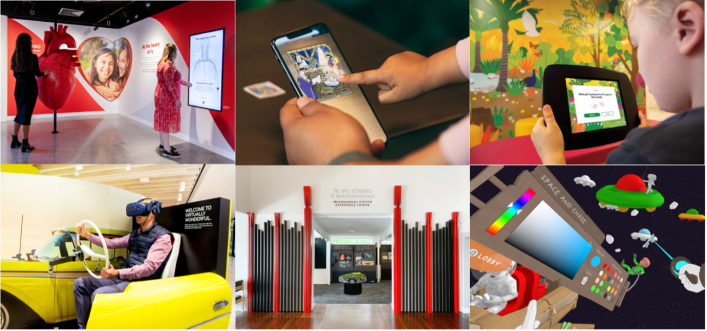In recent years we’ve developed our skills and experience in leveraging immersive technologies like Augmented Reality (AR), Virtual Reality (VR), digital interactives and gaming to help our clients tell richer stories and to engage with their customers, staff and communities.
Examples of our work include:
- The Mercury AR, VR and interactive brand showcase;
- The Heart Foundation ‘how the heart works’ interactive experience;
- The Maungawhau Mt Eden AR interactive visitors experience;
- The Colorway VR game in response to NZ’s teenage mental health challenge;
- The NZ Post AR Christmas stamp; and
- The Starship Wonderful Forest AR wall, developed with medical play specialists, to engage sick children going through complex medical procedures.

While the technology and its applications have come a long way in many years, many clients still think about AR and VR in the context of entertainment and exhibition. In a world where people are learning, communicating, shopping and living more of their life in a digitally-enabled space, immersive technologies offer many practical applications for businesses to enhance the customer experience, improve employee training, drive sales and marketing and deliver better outcomes right across their operations.
Immersive technology has become more accessible to more customers, businesses and industries, leading to a growing uptake which will only accelerate from here. In this article we explore 10 practical applications of immersive technologies that are happening in the real world today. We hope they inspire you to think about the opportunities in your business.
1. Enhancing Customer Engagement
- Virtual Product Try-on: Retailers enable their customers to try products virtually before making a purchase decision, removing potential sales barriers.
- AR advertising: Businesses create interactive and engaging advertisements using AR to give their marketing campaigns greater cut-through and impact.
- Virtual Showrooms: Real estate, interior design, and furniture retailer create virtual showrooms that allow customers to visualise spaces and products, leading to higher sales conversion rates.
2. Improved Training and Education
- Virtual Training Simulations: Using VR, businesses simulate real-world scenarios for staff training, especially in industries like healthcare, aviation, and manufacturing where hands-on training is crucial.
- Recreate places and event. Using AR and VR to transport students to see, hear and virtually walk-through places and major historic events.
3. Product Design
- Virtual Prototyping: Engineers and designers create virtual prototypes of products, allowing them to test and refine ideas, faster and cheaper, before investing in physical prototypes.
- Collaborative Design Sessions: VR sees teams collaborate in real-time on 3D models, enhancing the design process and speeding up product development cycles. This remote collaboration is particularly useful for global teams, remote workforces and with more people working from home.
4. Enhanced Customer Support
- AR-powered Support: Using AR to guide customers through troubleshooting processes, providing visual instructions to improve issue resolution rates.
- Virtual Help Desks: Virtual help desks where customers interact with support staff in a virtual environment, driving faster and cheaper issue resolution.
5. Data Visualisation and Analysis
- Data Visualisation: Overlaying real-time data onto physical objects to visualise complex datasets, aiding the decision-making process.
- VR Analytics: Using VR to visualise analytics data in immersive environments, helping make better contextualised decisions.
6. Event Experiences
- Virtual Conferences and Trade Shows: Virtual conferences and trade shows that reach national and global audience without the need for a physical presence.
- Immersive Product Launches: Launch new products with impactful, immersive and interactive experiences that create a buzz around the product.
7. Tourism and Real Estate
- Virtual Tours: Tourist destinations, universities, galleries and real estate firms are offering virtual tours, allowing potential audiences to experience the offerings remotely. This creates new revenue streams and/or converts traditional sales.
- Property Visualisations: Create immersive walkthroughs of properties that are yet to be built, helping buyers visualise their future homes and make informed decisions.
8. Brand Engagement
- Games and Apps: Create gamified AR applications to engage customers, enhance brand loyalty, and increase customer interaction with products or services.
- Interactive Campaigns: Interactive marketing campaigns, encouraging users to scan products or ads to unlock exclusive content, discounts, or experiences.
9. Healthcare and Therapy
- VR Therapy: Healthcare professionals are using VR to help patients overcome phobias, manage pain, and work through mental health challenges.
- Medical Training: VR simulations are used for medical training, allowing trainee doctors to practise surgeries and procedures in a risk-free virtual environment.
10. Health and Safety
- Safety Training: Industries such as manufacturing, construction, and forestry use VR and AR simulations to train employees on safety protocols and procedures in realistic, hazardous scenarios, reducing workplace accidents.
- Emergency Response Simulations: VR can be used to simulate emergency situations, enabling first responders to practise and improve their response strategies.
By integrating AR, VR, and other immersive experience tools into their business strategies, Kiwi companies can create unique and compelling experiences for their customers, streamline operations, improve training methods, and ultimately drive business results through increased efficiency, customer satisfaction, and innovation.
And while I can’t say we’ve done all the above, we have a proven ability to design and build immersive experiences that deliver to our clients’ briefs. We loving working in partnership with our clients to best determine how we use the available technology to unlock the business outcomes they need.
See more examples and case studies of our immersive experience work here.
